As I reflect on my quest to reduce utility bills without sacrificing comfort, I’ve come to realize that windows play a significant role in energy consumption. Astonishingly, they account for up to 30% of residential heating and cooling energy use. This epiphany led me to explore innovative solutions, and that’s when I discovered the potential of automated shades.
Automated shades, often referred to as smart blinds, promise to revolutionize the way we manage natural light and energy efficiency in our homes. By automating the process, these window coverings can significantly reduce energy waste. But the question remains: do they truly deliver meaningful energy savings compared to traditional window coverings?
Key Takeaways
- Automated shades can significantly reduce energy consumption by optimizing natural light usage.
- The return on investment for smart window coverings depends on various factors, including usage patterns and local energy costs.
- Comparing traditional blinds with automated shades can help homeowners make informed decisions.
- Energy efficiency improvements can be achieved through intelligent control of window coverings.
- Homeowners can benefit from reduced utility bills by adopting automated shades.
The Energy Challenge: How Windows Impact Your Utility Bills
As I examined my rising energy bills, I realized that windows play a significant role in energy loss. This realization led me to investigate further, and I discovered that windows are indeed a major culprit in energy inefficiency.
According to energy efficiency experts, windows typically account for 25-30% of residential heating and cooling energy use. During summer months, the sun’s rays streaming through unprotected windows can raise indoor temperatures by 10-20 degrees, forcing air conditioning systems to work overtime. Conversely, in winter, poorly insulated windows allow heated air to escape, creating “cold spots” throughout the home.
The challenge isn’t just about keeping heat in or out; it’s also about managing light effectively throughout the day as the sun’s position changes. Traditional manual blinds require constant adjustment to optimize energy efficiency, which most homeowners simply don’t have time to manage properly.
| Season | Energy Loss Cause | Effect on Home |
|---|---|---|
| Summer | Solar heat gain through unprotected windows | Increased indoor temperatures |
| Winter | Poorly insulated windows allowing heated air to escape | Cold spots throughout the home |
Understanding this window-energy relationship is the first step toward appreciating how smart blinds might offer a solution to this everyday problem. By effectively managing window coverings, homeowners can create an insulating barrier that significantly reduces energy transfer and lowers utility bills.
What Are Smart Blinds and How Do They Work?
With the rise of smart home technology, smart blinds have become an integral part of creating an energy-efficient home. Smart blinds are motorized window coverings that can be programmed, scheduled, and controlled remotely through smartphone apps, voice commands, or automation systems.
Unlike traditional blinds that require manual operation, smart shades use small motors powered by batteries, hardwired connections, or solar panels to raise, lower, and tilt automatically. The core technology includes motors, power sources (typically rechargeable batteries lasting 6-12 months), and wireless communication modules (WiFi, Bluetooth, Zigbee, or Z-Wave).
Most smart blinds connect to a central hub or directly to your home’s WiFi network, allowing them to be controlled through dedicated apps on your smartphone or tablet. Advanced models integrate with smart home ecosystems like Amazon Alexa, Google Home, or Apple HomeKit, enabling voice control with commands like “Hey Google, close the living room blinds.”
The real magic happens through automation—smart blinds can be programmed to adjust based on time of day, local sunrise/sunset times, room temperature, or even occupancy. Some systems use light sensors to automatically adjust based on the brightness level, maximizing natural light while preventing glare and heat gain. This automation creates an “install and forget” solution that optimizes energy efficiency without requiring daily manual adjustments.
When it comes to powering smart shades, there are several options. Most come with a rechargeable battery that can be charged in situ with a long enough cable. Some shades take standard batteries, though rechargeable batteries are recommended. Small solar panels are another option, though they might not be aesthetically pleasing from the outside. Always fully charge the battery before installation to ensure seamless operation.
Traditional Blinds vs. Smart Blinds: A Cost-Benefit Analysis
The choice between traditional and smart blinds hinges on understanding their respective costs and energy-saving potentials. When I first considered upgrading to smart blinds, I was struck by the significant difference in initial costs compared to traditional blinds.
Traditional blinds range from $20 to $200 per window, depending on size and material, while smart blinds generally start at $150 and can exceed $1,000 for premium custom options. Beyond the initial purchase price, installation costs also vary significantly. Traditional blinds are relatively simple DIY projects, while smart blinds often require professional installation, adding $50 to $150 per window.
- The technology investment for smart blinds may also include hubs ($50-$150) and potentially upgraded WiFi systems to ensure reliable connectivity throughout the home.
- Operational differences are another critical factor: traditional blinds require manual adjustment multiple times daily for optimal energy efficiency—a task most homeowners don’t perform consistently.
- Smart blinds eliminate this “human factor” by automatically adjusting to optimal positions throughout the day, maximizing energy efficiency without requiring daily attention.
Maintenance aspects also differ between the two. Traditional blinds have fewer components that can fail, but require regular cleaning and occasional cord or slat replacement. In contrast, smart blinds have more complex mechanisms but often feature easier cleaning designs.
Lifespan comparison is also crucial. Quality traditional blinds typically last 7-10 years, while smart blinds may have shorter lifespans of 5-8 years due to electronic components, though many offer warranties of 3-5 years.
In conclusion, while smart blinds come with a higher upfront cost and potentially shorter lifespan, their ability to automatically optimize energy efficiency can lead to significant savings over time. By weighing these factors, homeowners can make an informed decision about whether smart blinds are a worthwhile investment for their energy savings needs.
How Smart Blinds Can Reduce Energy Consumption
By intelligently controlling the amount of sunlight that enters our homes, smart blinds can help reduce energy consumption. This is achieved through the intelligent management of solar heat gain, allowing warming sunlight in during winter days and blocking it during summer days.
Through my research, I’ve discovered that properly automated smart blinds can reduce heating costs by up to 25% and cooling costs by up to 20% according to energy efficiency studies. This is because smart blinds excel at timing and can automatically close just before direct sunlight hits windows during hot summer afternoons, preventing the greenhouse effect that dramatically raises indoor temperatures.
- During winter, smart blinds can open during peak daylight hours to capture free solar heating, then close at sunset to trap heat inside and provide an additional insulating layer against cold windows.
- Beyond seasonal adjustments, smart blinds can respond to real-time conditions. Some systems integrate with smart thermostats to coordinate window coverings with HVAC operation for maximum efficiency.
- The insulating properties of closed blinds create a dead air space between the window and the room, reducing thermal transfer regardless of the season.
| Season | Smart Blinds Action | Energy Saving Benefit |
|---|---|---|
| Summer | Close before direct sunlight | Reduces cooling costs by up to 20% |
| Winter | Open during peak daylight, close at sunset | Reduces heating costs by up to 25% |
The energy savings compound in homes with many windows or large glass doors, where manual adjustment becomes increasingly impractical but automated systems scale efficiently. This makes smart shades and blinds a compelling option for homeowners seeking to reduce their energy consumption.
Calculating the ROI: Do Smart Blinds Pay for Themselves?
Determining whether smart blinds are a worthwhile investment requires a thorough examination of their return on investment (ROI) in terms of energy consumption and cost savings. To make an informed decision, we need to consider both the initial investment and the potential long-term benefits.
The initial investment in smart blinds can be substantial. For a medium-sized home with 15 windows, the cost, including installation, can range from $4,500 to $9,000. This significant upfront cost necessitates a careful financial analysis to understand its implications.
To evaluate the ROI, let’s first consider the potential energy savings. The average U.S. household spends approximately $2,200 annually on energy, with about 48% of this expenditure going towards heating and cooling, which amounts to around $1,056. Smart blinds can help reduce this cost by optimizing the use of natural light and minimizing heat transfer through windows. Potential savings of 15-25% on heating and cooling costs translate to $158-$264 annually.
ROI Calculation for Smart Blinds
| Category | Cost/Savings |
|---|---|
| Initial Investment | $4,500 – $9,000 |
| Annual Energy Savings | $158 – $264 |
| Payback Period | 17-57 years |
Based on energy savings alone, the simple payback period ranges from 17 to 57 years, which exceeds the expected lifespan of the product. However, this calculation doesn’t account for additional benefits such as increased home value, extended HVAC system lifespan, and reduced fabric fading of furniture and flooring.
Additional Benefits: Smart home features like smart blinds can increase resale values by 5-10%. Moreover, by optimizing energy consumption and reducing the load on HVAC systems, smart blinds can contribute to a longer system lifespan. The reduction in fabric fading due to controlled sunlight exposure also adds value by preserving the quality of furniture and flooring.
Time savings are another significant advantage. The average homeowner spends about 15-20 minutes daily adjusting window coverings, which amounts to 91-122 hours annually. Automating this task with smart blinds allows homeowners to redirect this time to more valuable activities.
For homes in extreme climates, the energy savings percentage can increase significantly, potentially doubling the financial return and shortening the payback period. To help readers determine their specific ROI, a customizable calculation formula can be applied, taking into account local energy costs, climate conditions, and window configurations.
Key Factors to Consider Before Investing in Smart Blinds
Before investing in smart blinds, it’s crucial to consider several key factors that can impact their effectiveness and overall value. As I’ve learned, making an informed decision requires evaluating various aspects of smart blinds and how they fit into your home.
One of the primary considerations is window compatibility. Not all window styles can accommodate motorized blinds, especially those with unusual shapes or opening mechanisms. Therefore, it’s essential to assess whether your windows are compatible with smart blinds.

Accurate window measurement is also vital. I recommend measuring each window multiple times and consulting professional guides to avoid errors that can lead to poorly fitting blinds. This not only affects aesthetics but also compromises energy performance.
The choice between custom-made and off-the-shelf products significantly impacts both cost and effectiveness. While custom options are more expensive (30-50% more), they provide precise fits that maximize energy efficiency. On the other hand, off-the-shelf products can be more budget-friendly but may not fit as perfectly.
- Installation complexity varies widely between products. Some smart blinds are designed for DIY installation, while others require professional mounting, especially when hardwiring is involved.
- The power source options (hardwired, battery-operated, or solar-assisted) each have distinct advantages and limitations that affect long-term maintenance and reliability.
- Smart home ecosystem compatibility is essential. Blinds that work with your existing smart home platform (Apple HomeKit, Google Home, Amazon Alexa) will provide a more seamless experience than standalone systems.
- Your local climate conditions should also influence your decision. Homes in extremely sunny locations benefit more from solar-reflective fabrics, while cold-climate homes might prioritize insulating properties.
- Privacy needs should factor into your decision as well. Some smart blind materials and designs offer better privacy protection than others, particularly at night when interior lights are on.
By carefully considering these factors, you can make an informed decision and choose smart blinds that meet your energy-saving needs and enhance your home’s comfort and functionality.
Top Smart Blinds for Maximum Energy Savings
To achieve maximum energy savings, it’s crucial to choose the right smart blinds for your home. With various options available, selecting the most effective model can be challenging. Here, we’ll explore three top-rated smart blinds that can significantly enhance your home’s energy efficiency.
SmartWings Motorized Light Filtering Roller Shades
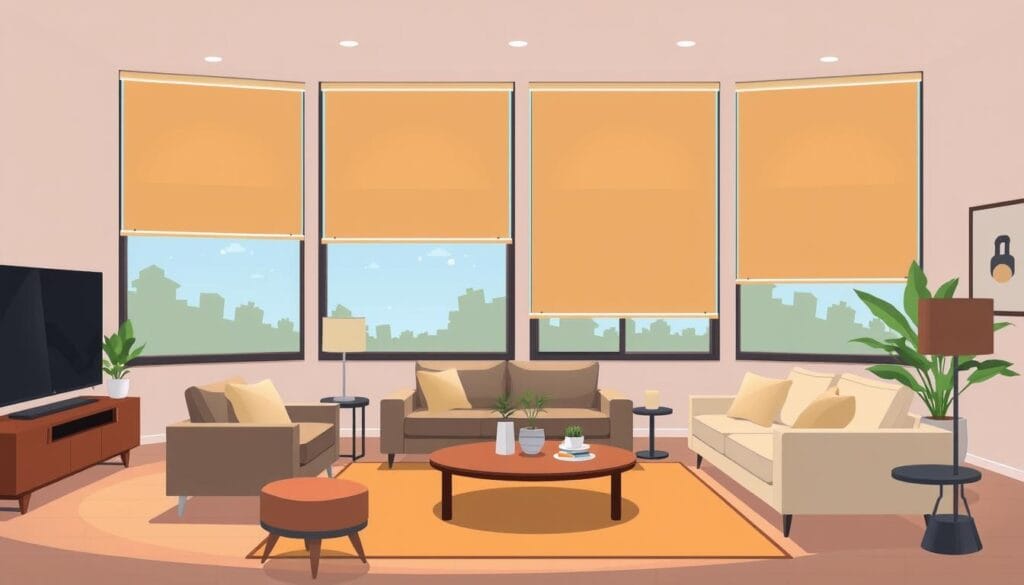
Overview
SmartWings Motorized Light Filtering Roller Shades offer a sophisticated solution for managing light and energy in your home. These shades are designed to be both functional and aesthetically pleasing.
Pros
Motorized Convenience: The motorized operation makes it easy to adjust the shades without manual effort.
Energy Efficiency: By controlling the amount of sunlight entering your home, these shades can help reduce the need for artificial lighting and heating/cooling.
Cons
While the initial investment in SmartWings shades can be significant, the long-term energy savings can offset this cost.
Features
The SmartWings shades come with a range of features, including programmable schedules and integration with smart home systems.
Lutron Serena Smart Roller Shades
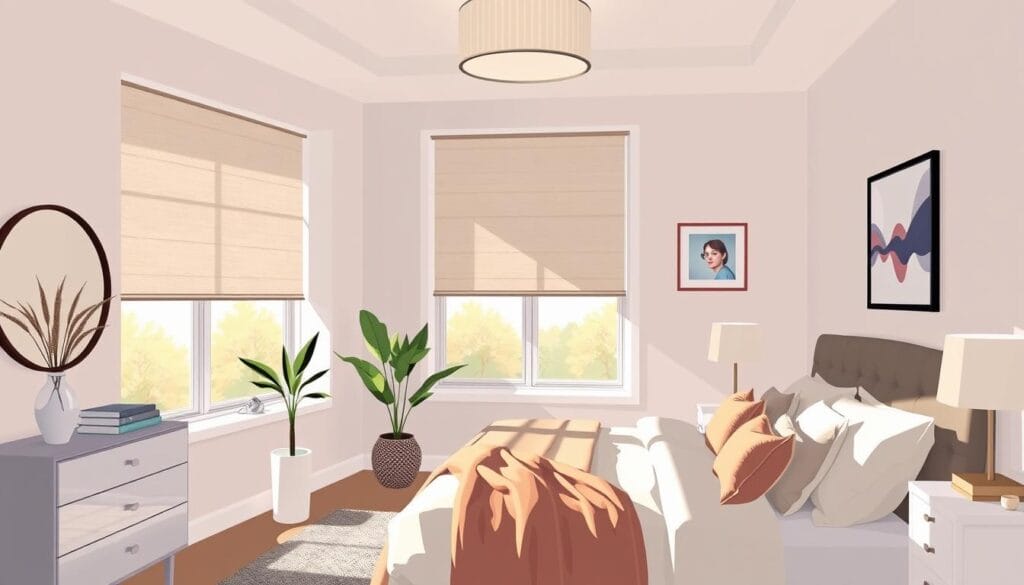
Overview
Lutron Serena Smart Roller Shades are renowned for their quality and functionality. They offer precise control over light and shade, contributing to a more energy-efficient home.
Pros
Precise Light Control: These shades allow for fine-tuned adjustments, ensuring optimal light levels.
Smart Home Integration: Lutron Serena shades can be integrated with various smart home platforms, enhancing their functionality.
Cons
Some users may find the installation process complex, requiring professional assistance.
Features
The Lutron Serena shades feature advanced technology, including a rechargeable battery that lasts up to a year and an optional solar panel for continuous power.
SwitchBot Roller Shade
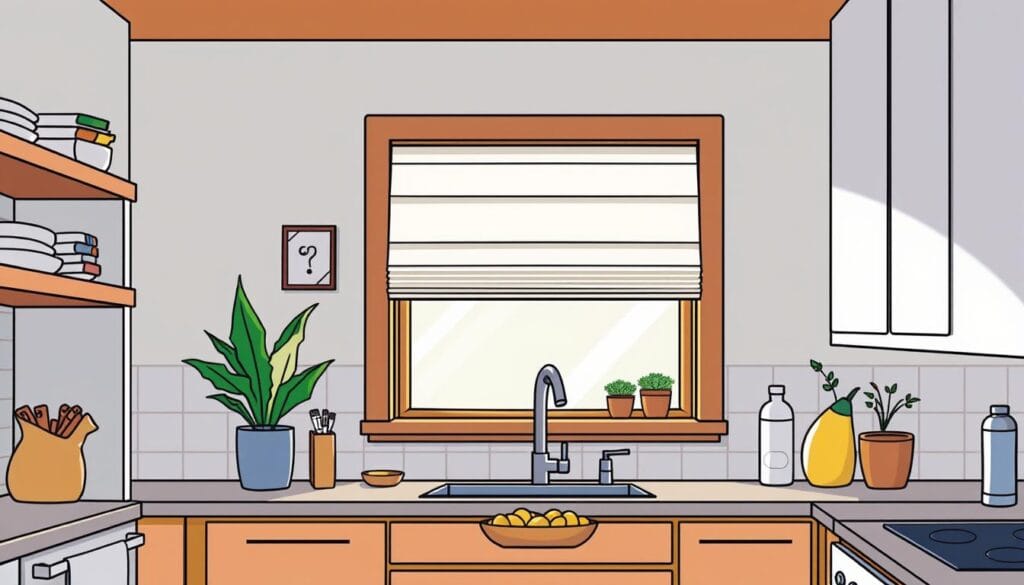
Overview
The SwitchBot Roller Shade is a budget-friendly entry point into smart blind technology, priced from $199 to $299 depending on size. It’s designed to be versatile and adaptable to various window sizes.
Pros
Affordability: The SwitchBot Roller Shade is competitively priced, making smart home technology more accessible.
Adjustable Design: It accommodates window widths from 22.8″ to 72.8″, making it suitable for different window sizes.
Modular Approach: The fabric panels are replaceable, allowing for changes in aesthetics or light-filtering properties without replacing the entire mechanism.
Cons
The SwitchBot Roller Shade requires the SwitchBot Hub2 for smart home integration, which is sold separately.
Features
The SwitchBot Roller Shade boasts a rechargeable battery lasting up to 8 months on a single charge, with an optional solar panel accessory. It operates at just 30dB in silent mode and is DIY-friendly. The SwitchBot app allows for group control of up to 8 blinds simultaneously.
Installation and Setup Process for Smart Blinds
When it comes to installing smart blinds, the first decision you’ll need to make is whether to go for an inside mount or an outside mount. This decision significantly affects the overall look and functionality of your smart blinds.
For an inside mount, you’ll need to ensure your window frame has sufficient depth, typically 2-3 inches, to accommodate the blinds. It’s also crucial to account for any obstacles like window cranks or locks that might interfere with the blind’s operation. On the other hand, an outside mount is more forgiving and can cover the window completely to block more light, but it may not look as aesthetically pleasing.
The installation process involves several key steps, including measuring your windows, installing mounting brackets, and connecting the blinds to power sources. Most smart blind systems come with mounting brackets that must be securely attached to either the window frame or the wall.
| Installation Type | Depth Required | Light Blocking |
|---|---|---|
| Inside Mount | 2-3 inches | Partial |
| Outside Mount | None | Complete |
After physical installation, the setup process continues with connecting the blinds to your home network and integrating them with any existing smart home systems. Allocating 30-60 minutes per window for a complete installation is recommended, with additional time for troubleshooting connectivity issues.
Smart Home Integration: Creating an Energy-Efficient Ecosystem
The true potential of smart blinds lies in their ability to integrate seamlessly with other smart home devices, creating a cohesive energy management system. This integration is key to maximizing energy efficiency and convenience in your home.
To achieve this integration, you need a hub that connects your smart blinds to other devices. Most shades come with a remote control, but to make them truly smart, a hub is necessary. This allows you to control the shades from your phone or using voice commands, enhancing the overall smart home experience.
When shopping for smart blinds, consider your current smart home setup and preferred voice assistant to ensure compatibility. While Bluetooth connectivity is an option, Wi-Fi or Zigbee connections are generally more reliable.
Integrating smart blinds with other devices creates a comprehensive energy management system. Some key benefits include:
- Smart thermostats working in concert with blind positions to optimize heating and cooling efficiency.
- Motion and occupancy sensors adjust blinds based on room usage.
- Voice control through assistants like Alexa or Google Assistant for manual overrides.
- Mobile apps provide remote management capabilities.
| Integration Partner | Benefits |
|---|---|
| Smart Thermostats | Optimize heating and cooling efficiency with blind positions. |
| Motion and Occupancy Sensors | Adjust blinds based on room usage for privacy and energy efficiency. |
| Voice Assistants | Enable manual overrides without disrupting automated schedules. |
By setting up “scenes” or “routines” that coordinate multiple devices simultaneously, you can further enhance your home’s energy efficiency. For example, a “Good Morning” scene can open blinds, adjust thermostats, and turn on lights in sequence for optimal comfort and efficiency.
Optimal Automation Strategies for Seasonal Energy Savings
To maximize energy efficiency, it’s crucial to implement optimal automation strategies for smart blinds throughout the year. Automation is the primary reason for investing in smart shades, and understanding what is possible is crucial to maximizing the benefits of this technology.
After testing various automation approaches across different seasons, I’ve developed strategies that maximize energy efficiency while maintaining comfort. For instance, during summer, programming south and west-facing blinds to close automatically around 10-11 AM can reduce cooling costs by up to 15%. In contrast, winter strategies involve opening east-facing blinds at sunrise to capture morning warmth and closing all blinds at sunset to retain heat.
The “shoulder seasons” of spring and fall require more dynamic approaches, with automation based on outdoor temperature forecasts and indoor temperature monitoring. Additionally, integrating with weather services allows for adjustments based on daily weather variations. For multi-story homes, different automation schedules for upper and lower floors can account for heat stratification.
Layering time-based, temperature-based, and sun position-based triggers creates the most responsive and energy-efficient automation system. Furthermore, occupancy-aware automation can adjust blinds differently when the home is empty versus occupied, prioritizing energy savings or comfort accordingly.
Real-World Energy Savings: Customer Experiences
By examining the experiences of smart blind users across various climates and home types, we gain a clearer understanding of their potential. To provide a realistic picture of what to expect, I’ve collected and analyzed experiences from dozens of smart blind users.
In hot, sunny climates like Arizona and Florida, users consistently report cooling energy savings of 15-30% after installing and properly automating smart blinds. The highest savings are observed in homes with large west-facing windows.
| Climate | Energy Savings | Notable Benefits |
|---|---|---|
| Hot, Sunny | 15-30% cooling savings | Significant reduction in cooling costs |
| Cold | 10-20% heating savings | Improved insulation, reduced HVAC strain |
Beyond energy bills, many users report unexpected benefits like reduced HVAC maintenance costs due to less system strain and extended equipment lifespans. Several users noted that their smart blinds revealed surprising insights about their homes’ energy performance.
As one user noted, “Installing smart blinds was one of the best decisions I made for my home. The energy savings have been significant, and I’ve noticed a considerable reduction in my utility bills.”
The financial impact varies widely based on local energy costs. Users in high-cost regions often achieve payback periods of 5-7 years through energy savings alone.
Potential Drawbacks and Limitations of Smart Blinds
While smart blinds offer numerous benefits, they also come with several drawbacks that need to be considered. One of the primary concerns is the initial cost, which can be prohibitively expensive for many homeowners, with premium systems costing between $600-$1,000 per window.
The power dependency of smart blinds is another significant limitation. Battery-operated systems require regular maintenance and charging, which can be inconvenient. On the other hand, hardwired systems may not function during power outages unless backup power is available. This vulnerability can be a significant issue for homes prone to frequent power outages.
| Limitation | Description | Impact |
|---|---|---|
| Initial Cost | High upfront cost of smart blind systems | Prohibitively expensive for many homeowners |
| Power Dependency | Reliance on battery or hardwired power | Inconvenience and potential system failure during outages |
| Hub Requirements | Need for multiple hubs in larger homes | Increased complexity and cost |
Furthermore, connectivity and privacy are also concerns with smart blinds. With cloud connectivity, these devices transmit data about your home usage patterns, which may be vulnerable to security breaches if not properly protected. Ensuring robust security measures is crucial to mitigate these risks.
In conclusion, while smart blinds offer many advantages, their limitations and potential drawbacks should be carefully considered. By understanding these challenges, homeowners can make informed decisions about whether smart blinds are the right choice for their energy-saving needs.
Future Innovations in Smart Blind Technology
As we look ahead, it’s clear that smart blind technology is on the cusp of significant advancements. The future of smart blinds is being shaped by several emerging technologies that promise to address current limitations and further enhance energy-saving potential.
Some of the key innovations include the development of self-powering smart blinds using advanced photovoltaic materials integrated directly into the fabric. This technology could potentially eliminate battery replacement and charging requirements. Additionally, adaptive opacity technologies, sometimes referred to as “smart glass” or “electrochromic windows,” are becoming more affordable and may eventually replace traditional blinds with window surfaces that can electronically adjust their transparency.
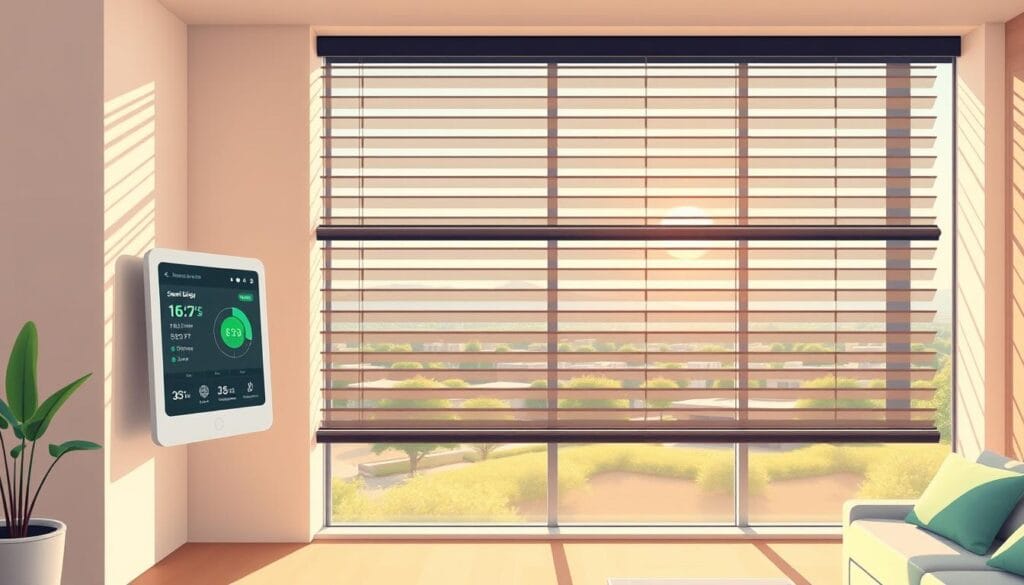
The integration of artificial intelligence is also advancing rapidly, with next-generation systems learning occupant preferences and optimizing for both energy efficiency and comfort without requiring manual programming. Furthermore, environmental sensing capabilities are expanding beyond simple light detection to include humidity, air quality, and precise temperature gradient monitoring, allowing for more sophisticated energy management strategies.
| Innovation | Benefit |
|---|---|
| Self-powering smart blinds | Eliminates battery replacement and charging |
| Adaptive opacity technologies | Electronically adjusts window transparency |
| Artificial intelligence integration | Optimizes energy efficiency and comfort |
| Environmental sensing capabilities | Enhances energy management strategies |
These advancements are poised to revolutionize the smart blind industry, providing even greater energy savings and comfort for users. As technology continues to evolve, we can expect to see even more innovative solutions emerge.
Is Your Home a Good Candidate for Smart Blinds?
Not every home benefits equally from smart blinds; let’s examine the characteristics that make them a worthwhile investment. To determine if your home is a good candidate, consider the following factors.
Homes with large window-to-wall ratios, exceeding 25% of the exterior wall surface, typically see the greatest energy benefits from smart blinds. The orientation of your windows also plays a crucial role, with south and west-facing exposures offering prime opportunities for energy savings.
| Window Orientation | Energy Savings Potential |
|---|---|
| South-facing | High |
| West-facing | High |
| North-facing | Modest |
| East-facing | Moderate |
Climate extremes amplify the potential benefits of smart blinds, with homes in very hot or very cold regions seeing faster payback periods. Existing window efficiency is also a key factor, with older single-pane windows paired with smart blinds achieving dramatic improvements. Additionally, homes with variable occupancy patterns or hard-to-reach windows benefit greatly from automation.
By assessing these factors, you can determine if smart blinds are a suitable investment for your home, potentially leading to significant energy savings and enhanced comfort.
Conclusion
By weighing the advantages and limitations of smart blinds, homeowners can make an informed decision about whether they are a worthwhile investment for their specific situation. After a thorough examination of their energy-saving potential, it’s clear that smart blinds represent a valuable solution for certain homes, though not universally applicable to every property.
The most compelling case for smart blinds emerges when energy efficiency is considered alongside other benefits such as improved privacy, UV protection, accessibility, and convenience. Homes that can leverage these multiple advantages achieve a more favorable overall return on investment. For maximum energy impact, strategic deployment rather than whole-home installation often makes more sense, focusing on west and south-facing windows in hot climates or large windows in cold climates.
Smart blinds offer a promising solution for enhancing energy efficiency, particularly when integrated with broader smart home systems. This integration significantly enhances their energy-saving potential, making them more attractive for homes already invested in compatible smart thermostats and home automation platforms. While traditional blinds remain viable for budget-conscious homeowners, they require consistent manual adjustment to achieve comparable energy performance, a behavioral commitment that most households struggle to maintain.
As energy costs continue to rise and climate concerns grow more pressing, the value proposition of smart blinds will likely strengthen, making them an increasingly practical component of comprehensive home energy management strategies. Ultimately, smart blinds represent a meaningful advancement in residential energy efficiency, balancing technological sophistication with practical everyday benefits and addressing window-related energy loss in a way that aligns with modern lifestyles.
FAQ
How do I control my SwitchBot Roller Shade?
You can control your SwitchBot Roller Shade using the SwitchBot Home app, voice commands with Apple Home or Google Home, or a remote control.
Is the SwitchBot Roller Shade easy to install?
Yes, the SwitchBot Roller Shade is designed for easy installation and can be mounted on your window frame without requiring professional help.
How long does the battery last on the SwitchBot Roller Shade?
The battery life of the SwitchBot Roller Shade can last several months on a single charge, depending on usage and settings.
Can I use the SwitchBot Roller Shade with solar panels?
Yes, the SwitchBot Roller Shade is compatible with solar panels, which can help extend the battery life and reduce the need for recharging.
Does the SwitchBot Roller Shade support Matter?
Yes, the SwitchBot Roller Shade supports Matter, ensuring compatibility with a wide range of smart home devices and platforms.
Can I purchase additional fabric or shades for my SwitchBot Roller Shade?
Yes, additional fabric or shades can be purchased separately, allowing you to customize your window treatments to suit your preferences.
How do I schedule opening and closing times for my SwitchBot Roller Shade?
You can schedule opening and closing times using the SwitchBot Home app, allowing you to automate your window treatments and optimize energy efficiency.
Are SwitchBot Roller Shades available with blackout shades?
Yes, SwitchBot Roller Shades are available with blackout shades, providing enhanced light control and energy efficiency.
Some images featured on this site are AI-generated for illustrative purposes. Actual product designs, specifications, and colors may differ from what is shown. All product names, logos, and brands are the property of their respective owners. Our reviews are based on independent research and may include affiliate links — if you purchase through these links, we may earn a commission at no extra cost to you.


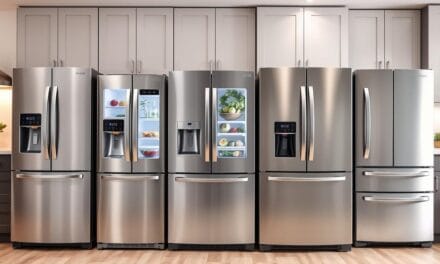

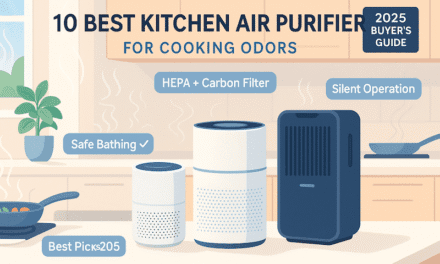
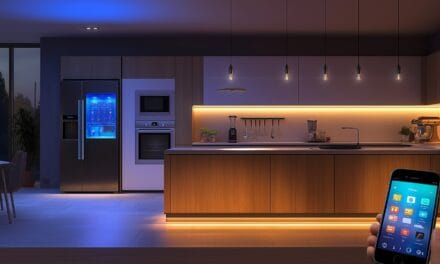

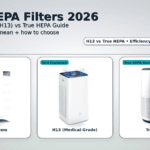

Recent Comments